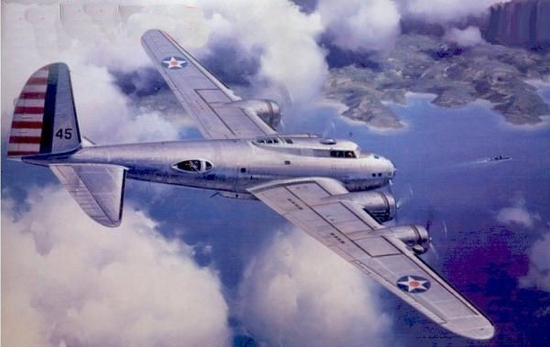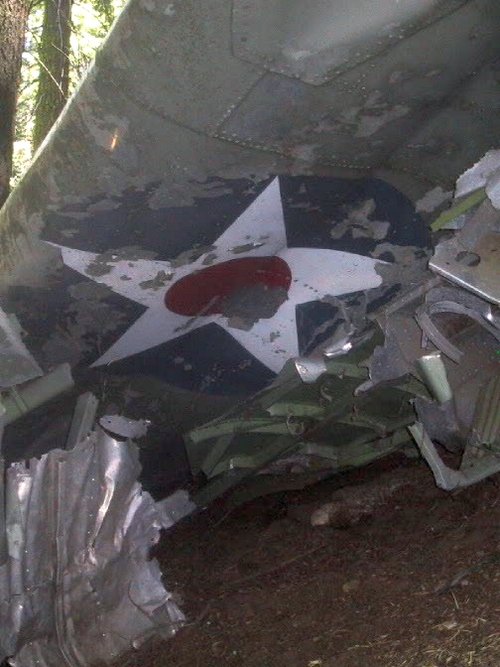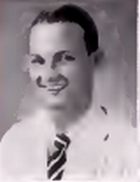Leo Walker
| Date and Place of Birth: | November 24, 1914 Gulfport, MS |
| Date and Place of Death: | November 2, 1941 nr. Georgetown, CA |
| Baseball Experience: | Minor League |
| Position: | Outfield |
| Rank: | First Lieutenant |
| Military Unit: | 9th Bomb Squadron, 7th Bomb Group USAAF |
| Area Served: | United States |
Leo M.H. Walker was the younger brother of major league outfielders Gerald "Gee" and Harvey "Hub" Walker, and was known to them as "Big Shorty." As a youngster he survived a serious accident, when he dived into a shallow pool and cracked a vertebra. He dragged himself to the shore, lost consciousness and remained on the bank all night. His neck was in a cast for many months. [1] Nevertheless, Walker made a full recovery, playing baseball and football in high school.
In 1935, Walker enrolled as a freshman at the business school at the University of Mississippi where his brothers had previously excelled as ballplayers. The following year, he was signed by the Cincinnati Reds (his brother Hub was with the Reds at the time), and was optioned to the Andalusia Reds of the Class D Alabama-Florida League. But after a brief trial, he quit baseball.
Leo Walker joined the
Army Air Corps in 1940, and earned his wings as a bomber pilot at
Randolph Field, Texas. First Lieutenant Walker was assigned to the 9th
Bomb Squadron of the 7th Bomb Group at Fort Douglas in Salt Lake City,
Utah, where he flew the Boeing B-17C Flying Fortress. In October 1941,
with the everincreasing territorial gains by the Japanese in the
Pacific, the 7th Bomb Group was preparing to leave Salt Lake City to
reinforce the Far East Air Force in the Philippines. The group's B-17s
were scheduled to depart for Hickam Field, Hawaii on December 6, 1941.
On October 31, 1941, 1/Lt. Walker piloted his B-17C on a journey to
Sacramento, California, where it was to have an engine changed at the
Sacramento Maintenance Depot. On board with Walker were four other crew
members and four passengers. The passengers were there to help out with
the engine change. As the B-17 approached Reno, Nevada, the weather
deteriorated and Walker landed at Reno to wait for conditions to
improve. After waiting two days, the crew were anxious to get going and
left Reno at 11:15am on November 2. After passing the north end of Lake
Tahoe, the B-17 entered cloud cover and began to climb to get above it.
Experiencing severe turbulence, the plane was at 18,000 feet and still
not out of the clouds when the #1 supercharger began to fail. This meant
they did not have sufficient power to climb above the clouds and decided
to return to Reno. At this stage, Walker ordered everyone to put on
their parachutes. Shortly afterwards, the plane rolled over onto its
back, briefly righted itself, then fell into a spin. While Walker stayed
at the controls the remaining crew and passengers abandoned the plane;
some unwillingly. Cpl. Sterling Isom was thrown through the glass of a
gunner's turret, while Pvt. Alden H. Stookey was ripped out through a
gaping hole in the fuselage. As the eight men drifted safety in the
Sierra foothills, thanks to the parachutes Lt. Walker had ordered them
to wear, they saw the B-17 in pieces, falling from the sky.
The plane crashed 25 miles
west of Lake Tahoe, California, in the El Dorado National Forest. Two
days later, forest rangers searching through the rugged area near Tells
Peak discovered the wreckage with Leo Walker's body still at the
controls. [2]
"Unlike Gerald and Harvey," The Sporting News declared
following news of his death, "Big Shorty never made the big league - but
he made the grade as a soldier." [3]
More than 70 years later, a great deal of the wreckage still remains at the crash site.
|
Year |
Team |
League |
Class |
G |
AB |
R |
H |
2B |
3B |
HR |
RBI |
AVG |
| 1936 | Andalusia | Alabama-Florida | D | - | - | - | - | - | - | - | - | - |

Boeing B-17C Flying Fortress. The type 1/Lt. Walker piloted on a journey to Sacramento, California, in November 1941

Wreckage stills remains at the crash site in the El Dorado National Forest
Notes
1. The Sporting News, November 13, 1941
2. Had Leo Walker not died that day he most likely would have been one
of the 7th Bomb Group pilots that arrived at Hickam Field just as the
Japanese attack began on Pearl Harbor on December 7, 1941. Several
airplanes were lost that day to enemy attack and friendly fire.
3. The Sporting News, November 13, 1941
www.check-six.com/Crash_Sites/Sierras_B-17C_crash_site.htm
Date Added May 22, 2012 Updated June 12, 2014
Baseball's Greatest Sacrifice is associated with Baseball Almanac
Baseball's Greatest Sacrifice is proud to be sponsored by

